

Originally posted December 21, 2015
The Gun of the Week this week is the Winchester Model 94.

This rifle has an extremely recognizable profile, such that many people who aren't familiar with firearms will recognize it, if not specifically as a Winchester Model 94, probably by the brand name or at least as a 19th-century repeating rifle. Its ancestors go back to one of the earliest repeater designs.
Probably the earliest precursor to this rifle, in terms of appearance and general operation (not in terms of its internal workings so much as the controls, what we would now call the user interface) was the "Volition Repeater" rifle, which debuted in 1848. The metallic cartridge hadn't really been invented when the Volition came along, so instead, it used an odd, now-mostly-forgotten ammunition type called the Volcanic or "rocket ball" system. Volcanic rounds were basically big conical bullets with their hollow bases stuffed with propellant (hence the term "rocket ball"). Sort of primitive caseless ammunition, or a distant precursor to the also-failed but interesting GyroJet rocket guns of the 1960s.
The Volition was never made in great numbers, and a competing product called the Jennings made it to the open market but didn't fare much better. They were followed by a line of weapons based on the Volcanic patents and named accordingly, which were interesting and are now quite desirable but which also pretty much flopped at the time they were offered for sale. There's a lot of firearms history bound up in the story of those various market failures, as it happens, because four of the people involved in the Volcanic company were Horace Smith, Daniel Wesson, Benjamin T. Henry, and Oliver Winchester. Smith and Wesson went on to other things, as their names may suggest, but Henry and Winchester kept pursuing the concept of the repeating rifle.
One of the things they did in the course of chasing that rabbit was abandon the Volcanic rocket bullet—they couldn't hold very much propellant anyway, and they had an unfortunate habit of all going off at once in the magazine sometimes, which was unpopular—and looking instead to the recently invented self-contained metallic cartridge. Early metallic cartridges were made of rolled foil, which made them fragile and unsuitable for use in anything with a mechanized action; they were meant to be loaded carefully by hand, one at a time. Only when the modern drawn brass cartridge case came along could a mechanical repeating rifle really work.
By 1860, that had happened, and Henry's refined version of something like the Volition action debuted that year. This was the year before the American Civil War began, at a time when muzzleloading rifles were still the Usual Thing and single-shot, cartridge-firing breechloaders were still regarded as newfangled—and along came a rifle (carbine, really, they were quite short by the standards of the day) that could fire sixteen times before needing to be reloaded. The modern Henry Repeating Arms company (which has no actual relation to the 1860s manufacturer of the Henry, New Haven Arms Co.) still uses as its slogan the joke that was coined about the Henry during the war, "Load on Sunday and shoot all week."
After the war, the New Haven Arms Company was reorganized under the name of its principal shareholder, Oliver Winchester, and started selling an improved version of the Henry called the Winchester Model 1866. This was followed by an updated model in 1873; in a cunning marketing move, the Model 1873 was offered in several popular handgun chamberings of the time, the idea being that people out on the frontier would only have to carry one kind of ammunition for both their guns. It was so popular and so closely identified with the Wild West that there was actually a Western film released in 1950 called Winchester '73.
There followed the Model 1876, which looked very similar but was significantly larger and stronger so as to support the heavier rifle cartridges favored by big-game hunters. In one of those odd turns the history of firearms design sometimes take, though, the most popular of those cartridges in the market turned out to be one the Model 1876's action was too short to accept, so the company found itself looking for a replacement almost immediately.
Enter John Moses Browning (1855-1926), probably the most prolific American firearms designer in history and certainly one of the two or three best-known. At the time, Browning was working exclusively for Winchester, and his second job for the company (after coming up with a single-shot rifle, the Model 1885) was to develop an even bigger and sturdier successor to the Model 1876. This he promptly did, offering up the Model 1886. This was capable of handling some truly monstrous big-game cartridges, such as the .50-110 Express, a gigantic round meant for killing bison.
A quick note about cartridge nomenclature may be in order here. American rifle cartridges of the time were named under a system that first indicated their bore diameter in inches, then the volume of the cartridge case they used, specified by the number of grains of black powder they could hold. (The grain is a unit of weight, not volume, but since black powder had a standard density, it amounted to the same thing.) A hundred and ten grains of black powder is a hell of a lot. Compare the standard military cartridge of the time, the .45-70 Government, which was... not considered underpowered by anyone not shooting at very large hornèd animals.
Anyway, the Model 1886 in this story is a little bit like the Lee-Metford in the last one. It came along right at the time when the new smokeless powders were coming in, and one of the immediate effects of those propellants—more powerful and faster-burning than black powder—was to bring smaller bullets with more powerful charges behind them into fashion. The strength of the Model 1886 action was up to the challenge, but the rest of the rifle needed to be redesigned and rethought in order to take best advantage of these new rounds that were coming along.
First, however, came the "smokeless" revision of the 1873, which, like its predecessor, was meant to be chambered for various popular handgun rounds of the time. This was the Model 1892, which later turned up in a lot of Westerns because it looked like the Model 1873 but was cheaper and easier to find ammunition for in 1950s Hollywood. If you've ever seen the old TV series The Rifleman, starring Chuck Connors, the title character carries a Model 1892. So did Steve McQueen's character on Wanted: Dead or Alive, though his had been cut down into a sort of giant pistol.
At any rate, once the 1892 was established, the next step was to come out with the Designed For Smokeless revision of the 1886. This was the Model 1894, which brings us back to where we started from, because we're looking at one here. (The Model 1894 was also the last of the Winchester lever-action centerfire rifles to use a tubular magazine and look like the Henry; later models either used a vertical box magazine, or were chambered in .22 rimfire.)
These rifles were manufactured for a ridiculously long time. As their original model number suggests, they entered production in 1894. Would anyone like to guess when they stopped making them? 1895, when the "successor" model with the box magazine came out? 1942, when war demands meant that America's firearms manufacturers had better things to be doing with their production capacity? Maybe 1955, when the all-new, cutting-edge Model 88 (they'd stopped using the years in model numbers by then, obviously) debuted?
Nope, you're quite wrong! The Winchester Model 94 (they dropped the "18" around the same time they stopped using years of release as model numbers generally) remained in continuous production, through all the various changing of hands that the Winchester brand name went through, until 2006, when the last U.S. incarnation of the company finally closed up shop.
And then went back into production in Japan in 2011. They're still making the dang things today, and—here's a curious bit of circular history—selling them in the U.S. under the Winchester name by way of the Browning Arms Company, on behalf of the current owners of both of those brand names, Fabrique Nationale of Belgium (about whom much more later).
Anyway! None of that had happened yet when the Model 94 we're taking a look at today was made. It even predates the great manufacturing simplification of 1964, when (in classic Hardcore Fandom style) many Model 94 enthusiasts still maintain that it was Ruined FOREVER. This one is a 20-inch-barreled carbine (they were also sold with 26-inch barrels) and dates to 1946. Let's take a closer look at the action.
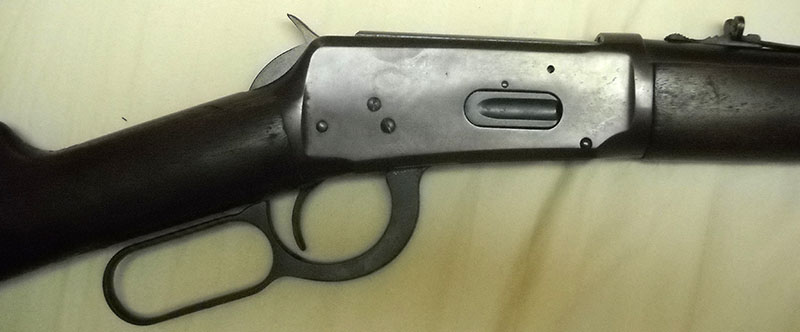
Here is the action all closed up, with the hammer down. Note the port on the side of the receiver: that's the loading gate. It's spring-loaded—you slide the nose of the bullet into the groove in the middle of it and push forward. The magazine is the tube underneath the barrel, visible in the full-length photo. Cartridges used by the Model 94 have round-nosed bullets, so that they don't have the nasty habit of the nose of one bullet slamfiring the primer of the round in front of it that some other tube-magazine rifles have displayed over the years. This particular one holds six rounds (26-inchers could hold eight).
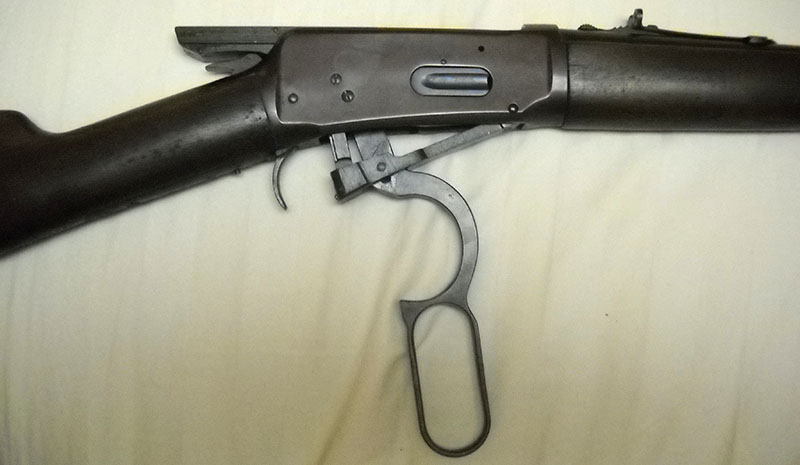
Here's the action fully opened. Note the position of the lever, and the way the rearward travel of the breechblock has automatically cocked the hammer. The idea behind the lever action is that you would hold the rifle naturally with the last three fingers of your shooting hand inside the loop of the lever, and so work the action without having to change the position of either hand very much. This makes for a fast recovery, and enables the shooter to stay more or less on target between shots, a great luxury compared with single-shot breechloaders. It takes practice, but it can be done. The tubular magazine also means you can add new rounds whenever you like, without waiting for the rifle to run completely empty, which was very popular with the cavalry.

Looking down into the top, we can get a sense of how the action works. The chamber mouth can be seen at the right of the photo (the rifle's muzzle is to the right); to its left is the elevator, which serves two functions. That tab on the front of the bolt, in back of the elevator, is the extractor. It hooks the rim on the fired cartridge and pulls it out of the chamber as the bolt slides to the rear; when it's all the way back, the elevator pushes the next round up from the magazine below, in the process flipping the empty out of the breech. Then, when you pull the lever back up again, the elevator drops down to receive the "on deck" round from the magazine (which has a spring in it that always wants to push the rounds toward the back of the rifle), while the bolt comes forward, pushing the fresh round into the chamber (and engaging the extractor with its rim, ready to pull it out again). It's a strong, reliable action without a lot of extraneous moving parts, which sets it apart from the Winchester lever rifles from before Browning came along, even though they all look very similar from the outside.
Also visible in this shot are the factory proof marks on the receiver and barrel. These indicate that both components have been tested to a specified pressure (generally much higher than the expected pressure of the cartridges to be fired) and proved to be undamaged by the overload when subsequently inspected. Proofing of one kind or another is required by law in many countries, and proof marks are practically a Ph.D thesis in gunology all by themselves.
Speaking of markings, here is the engraving to be found on the left side of the barrel of this particular Winchester:

These markings varied a lot over the model's long lifespan. These are interesting in that they date this rifle to a fairly narrow span of time, such that the approximate year of its manufacture could be worked out even without a serial number lookup. I don't have the book right here to check, so I'm going from memory, but I believe that particular configuration of markings debuted during World War II, say in 1942 or '43, and revised sometime around 1950; but the cartridge designation shown there was changed in 1947, so this one had to be made before then. This rifle is in what is now called .30-30 Winchester, but before 1948, Winchester called it .30 Winchester Center Fire and other manufacturers, not wanting to put the Winchester name on their own products, called it ".30-30".
(This was a takeoff on the old "caliber-grains of powder" nomenclature from black powder days, but indicated .30 caliber with a standard load of 30 grains of smokeless powder. Unlike the similar black powder notation, this was not an indicator of the volume of the cartridge case; black powder cartridges had to be full of powder, smokeless cartridges don't. In fact, if you filled the case of most smokeless cartridges right to the bottom of the bullet, you would probably blow up the gun.)
Anyway, in '47 Winchester and the other manufacturers recognized that calling the same cartridge by two almost completely different names was confusing everyone's customers, so they compromised. The official name of the cartridge became .30-30 Winchester, and the other companies could then omit "Winchester", or elide it into ".30-30 Win" or ".30-30 W", or whatever. The public would still be buying boxes of ammo that clearly said ".30-30 Winchester", but what the hell, at least Marlin, Savage et al. didn't have to actually put the word "Winchester" on their own products.
One interesting thing about the Model 94 is that for almost a hundred years, it didn't have a safety beyond expecting its operators to know what they were doing. An explicit safety mechanism with a switch to turn it on wasn't included until 1992, when the lawyers finally forced the addition of one. (I probably didn't need to note that this was another occasion on which, if you ask the die-hards, the Model 94 was Ruined FOREVER.) Before that, there were two safety systems in place on the Model 94, but one was not obvious to the layman and the other was not a mechanism.
The non-obvious one was that the hammer had a sort of half-cock position. On the left, it's all the way down, as if the rifle has just been fired, and on the right it's shown at half-cock:
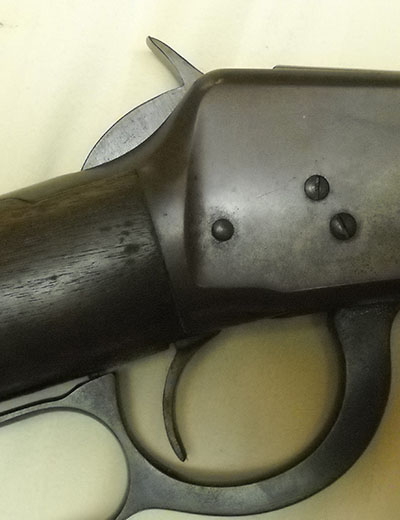
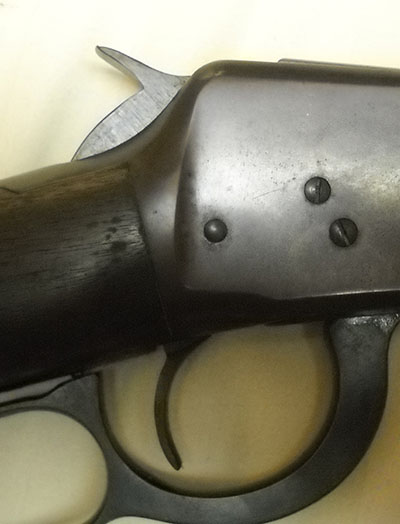
As you can see, the "half-cock" position is nowhere near actually halfway back, but that's what it's called anyway, so we'll go with it. For comparison, below is what it looks like when fully cocked and ready to fire.
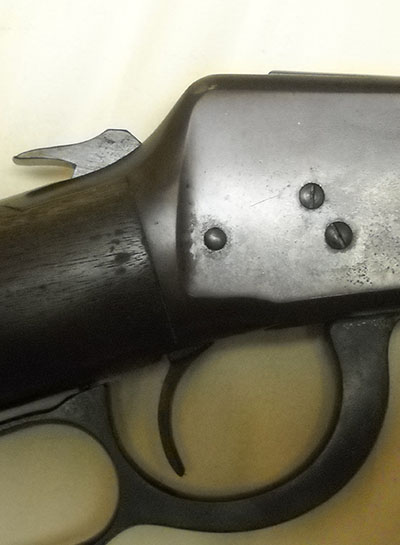
At half-cock, the trigger does nothing, and since the hammer is not touching the firing pin, an accidental impact to the back of the rifle (such as if, for instance, it's dropped) shouldn't set off a chambered round. This is the way firearms with single-action triggers were made safe to carry for decades before the Model 1894 came along, and decades after it went into service. It was widely acknowledged among shooters even back in those days that this was not the most reliable way of doing it, particularly in (for instance) early Colt revolvers, but it was only considered secondary to the true safety technique for such firearms, which was not to carry them with a loaded chamber under the hammer in the first place.
In a revolver, this was done (as previously discussed) by leaving one chamber empty and making sure it was the one at top dead center when you were carrying. (In practice it often wasn't empty empty, it just didn't have a round in it. A lot of people, particularly out West, carried some rolled-up money in there. The old joke was that if you lost a gunfight, at least the townsfolk wouldn't have to pay to bury you.) In a levergun, which was after all meant to be carried in a saddle pouch or the like and not usually on one's person, you were meant to just load the magazine and leave the chamber empty until you actually needed to shoot something. This is still quite a sound practice, and relies on no mechanical addition to the rifle to achieve.
Many of the items we've seen in Gun of the Week so far have had some individual personal history as well as the overall history of the type we've seen above, and this one is no different. This is my father's Model 94, which was in turn his father's until Dad moved away from home in the early '70s, and it has a little bit of a family legend attached to it. You see, back when Dad was a kid, one of the various jobs his father had was as a freelance gunsmith, and at one point he was hired by the proprietor of a hardware store that had had a serious fire. The job was to salvage whatever he could from the store's stock of guns (this was not at all an uncommon sideline for hardware stores in Maine in the '50s to have), and if he had any success, he could keep the best of the "patients" for himself.
This Winchester was that gun, and on the bottom corner of its buttstock it still bears a reminder of the ordeal that brought it into our orbit:
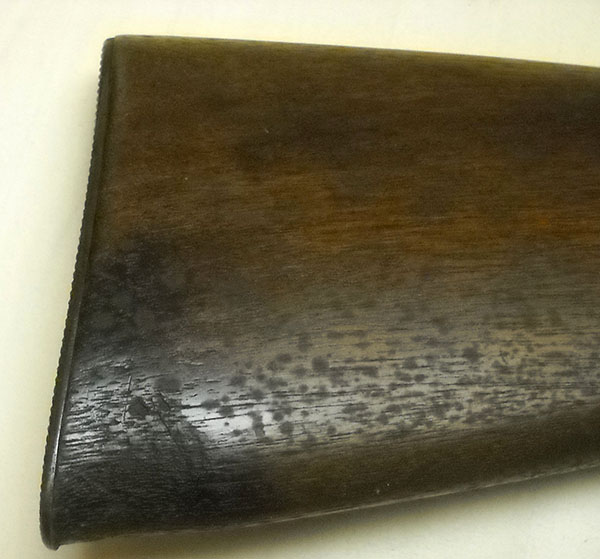
It's been refinished, obviously, but you can still see the charring. This particular rifle ended up being right at the edge of the destroyed part of the store; its finish was ruined by the heat and the water used by the firemen to control the fire, but apart from that little eaten-away bit of the stock, it was undamaged. Gramp made certain the metal parts hadn't been exposed to enough heat to warp them or ruin their temper, reblued them, oiled the stock, and it's been in the family arsenal ever since.
That's about it for this week. Next week, back to handguns, I think.
--G.